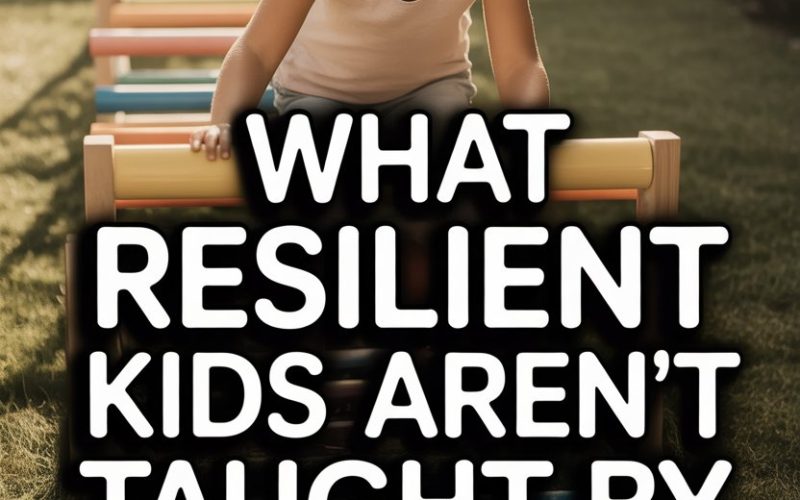Ever found yourself staring at your child mid-tantrum, clutching a lukewarm coffee, and wondering how on earth some kids seem to bounce back from anything while yours appears ready to retire at the first hint of adversity?
Spoiler: resilience rarely appears by magic, and it’s not hiding in the sock drawer.
Kids don’t just absorb grit through osmosis or by snacking on enough organic kale. There are things truly resilient children—and their parents—do on purpose.
Here’s what doesn’t happen by accident for resilient kids, and how you can bring those lessons home, even if your idea of ‘wellness’ is hiding in the loo for five minutes of peace.
They Don’t Learn Struggle Is a Sign of Failure
Somewhere along the line, many of us got it in our heads that if a child is struggling, something’s gone terribly wrong. Cue frantic Googling and a collective parental sigh.
Actually, struggle is the gym where resilience gets buff.
Resilient kids understand that stumbling is part of the deal. This isn’t plastered on a worksheet or whispered in the night by the Tooth Fairy—it’s modeled by parents who let their kids see them wrestle with challenges and try again.
Try narrating your own tricky moments. “Wow, this IKEA instruction manual is basically ancient runes, but I’m going to keep at it!” Kids watch and learn that even adults don’t have it all sorted.
And if you need a little science to back you up, Stanford’s Carol Dweck found that praising persistence, not just achievement, fosters a growth mindset—where effort matters more than perfection.
They Don’t Absorb Self-Regulation Through Osmosis
Meltdowns over mismatched socks? Welcome to the club. But resilient kids don’t just wake up knowing how to calm themselves down when life throws a wobbly.
Self-regulation is taught, not caught.
When a child is losing the plot, it’s tempting to just fix the problem (“Fine, you can have the blue cup!”), but they need help learning what those big feelings are and what to do about them.
Try the name-it-to-tame-it trick: “It looks like you’re feeling really frustrated because your tower fell down. That’s tough. Let’s take three deep breaths together.” (Bonus: This often works for grown-ups, too.)
For a bit of backup, check out Dr. Stuart Shanker’s work on self-regulation.
They Aren’t Magically Immune to Discomfort
Nobody likes seeing their child uncomfortable. If you could, you’d probably smooth out every bump, butter up every social hiccup, and clear away every disappointment.
But resilience grows when kids learn they can survive a day that doesn’t go their way.
When you let your child face manageable discomfort (the key word here is manageable), you send a powerful message: “You can handle this. I believe in you.”
Resilient kids are the ones who know a little awkwardness or boredom won’t actually cause spontaneous combustion.
Let them wait their turn, lose the game, or walk into a new club on their own. Stay close, stay supportive, but let the discomfort do its work.
Harvard’s Center on the Developing Child calls this “serve and return” support—being present, not taking over.
They Aren’t Coddled Out of Consequences
It’s easy to swoop in and rescue your child from every misstep, lost jumper, or playground spat. But resilient kids learn early that choices have consequences, and those consequences aren’t punishments—they’re teachers in disguise.
Forgot the lunchbox? They’ll be a bit hungry for a day, but you can bet they’ll remember it tomorrow (or at least until the next distraction). Didn’t finish the project? The world keeps turning, and they learn about planning ahead.
This isn’t about being harsh. It’s about letting natural consequences do the teaching, while staying warm and loving.
Psychologist Dr. Laura Markham suggests that natural consequences foster responsibility and self-correction—once kids see adults won’t always step in, they step up.
They Don’t Learn Optimism Through Platitudes
“Just think positive!” said no genuinely resilient person, ever. Kids don’t build optimism by being told to cheer up or look on the bright side while their Lego masterpiece lies in ruins.
Resilient children develop a realistic optimism. They learn to spot what is still going well, or what they can influence, rather than denying difficulties exist.
Instead of “It’s fine!” (when it clearly isn’t), try: “That stinks, but you’ve fixed things like this before. Want help coming up with a plan?”
Teaching optimism is an active process. Dr. Martin Seligman found that when kids are guided to reframe setbacks—seeing them as temporary and specific, not permanent and global—they bounce back faster.
They Aren’t Born with Assertiveness
Ever met a child who seems to know instinctively how to set boundaries and say what they need, without being a tiny dictator? Lucky you. For everyone else, assertiveness needs a bit of scaffolding.
It’s not just about saying “no”—it’s about expressing needs respectfully and standing up for oneself. This doesn’t come from lectures or wishful thinking, but from daily chances to practise.
Role-play is your friend, especially before sticky situations: “What could you say if someone wants your snack, but you’re still hungry?” Help them find their voice—sometimes, literally—as you cheer on even the smallest attempts to speak up.
PsychCentral recommends building assertiveness gradually, starting with small choices and growing into trickier scenarios.
They Don’t Learn Empathy from Selfies
Empathy is often the unsung hero of resilience. If you can tune in to others, you’re more likely to build strong relationships, bounce back after social setbacks, and know when to reach out for help.
Empathy isn’t transmitted through Wi-Fi, nor does it settle over children by accident during circle time. It takes real-life practice.
When your child is unkind, or on the receiving end of drama, help them wonder, “How do you think Jamie felt?” For little ones, picture books about big feelings make a handy jumping-off point.
And don’t forget your own modelling: talk about your feelings, the characters in stories, or even the people you meet in the queue at the shop.
According to Harvard psychologist Dr. Richard Weissbourd, empathy grows when parents make it a family value.
They Don’t Magically Develop Problem-Solving Skills
The ability to solve problems, big and small, is the secret sauce of resilience. But no child just wakes up one day able to split the atom—or even put together their own sandwich—without a bit of guidance.
Start with small, everyday problems and resist the urge to provide every solution. When your child comes to you with a dilemma (“I can’t find my favourite shirt!”), try asking, “What ideas do you have?” rather than springing into action.
For even more structure, walk them through the classic problem-solving steps: identify the problem, brainstorm options, weigh the outcomes, pick a plan, and reflect on how it went.
Kids Helpline offers simple scripts for these moments.
They Don’t Grow Resilience Alone
The myth of the self-made, superhero child exists mostly in parenting books and late-night worries. Every resilient child has a network—parents, teachers, aunties, neighbours—cheering them on and lending a hand.
What matters most isn’t a perfect parent, but a present one. A warm, stable relationship is the trampoline that lets kids bounce back when life throws them off track.
If you’re wondering how to squeeze that into your day, don’t underestimate the power of a one-on-one chat, a shared laugh, or five minutes of silly play.
According to the American Psychological Association, strong connections are the bedrock of resilience.
Real Kids, Real Growth
Some days, resilience feels like a distant prize—perhaps awarded only to families who eat quinoa without complaint.
The real secret? Those bounce-back skills aren’t hidden in some secret parenting handshake. They’re built through daily, sometimes messy, always intentional acts.
You won’t teach all these lessons at once. (Frankly, you’ll be doing well to get a shower and remember where you left your keys.)
Pick one small thing this week: narrate your struggle, let your child face a small discomfort, ask them how someone else might feel.
Resilience doesn’t arrive by accident. But it doesn’t require superhuman parenting, either—just a willingness to let kids wrestle with life, knowing you’re there to spot them as they climb.
Now, about that IKEA manual…





